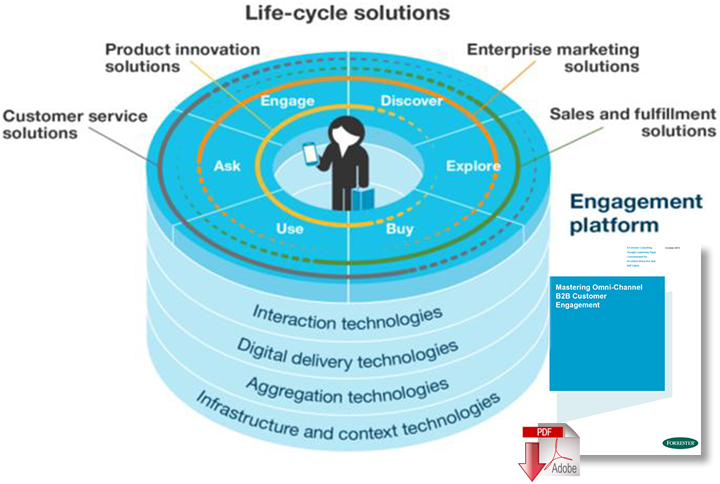Omnichannel Returns
According to Forrester Research, the adoption of ecommerce solutions is accelerating, driven by the advantages offered by Omnichannel strategies.
So much, in fact, that Forrester is recommending business-to-business (B2B) and business-to-consumer (B2C) businesses embrace an omnichannel strategy - one that offers several significant benefits to both retailers and wholesalers alike.
Technologies Must Support The Customer Journey
Source: “Elevate Omnichannel Customer Experience With Continuous Business Services,” Forrester Research
In essence, omnichannel adoption can tear down silos and reduce operational overhead while bringing more opportunities to businesses looking to sell products and services.
However, omnichannel solutions are still plagued by supply chain inefficiencies that can reduce value and hamper productivity.
Take, for example, that returns management process, where defined methodologies for handling customer returns have become high-touch processes that can introduce delays, inefficiencies, and mistakes - all of which can impact the bottom line while also affecting the relationship with the customer.
The simple fact of the matter is that any customer-facing organization must support the ideology of processing returns; whether or not that process can be efficient and productive comes down to how returns are handled.
Retailers and wholesalers often view returns management and reverse logistics as necessary evils, and attribute processing returns to the costs of conducting business.
However, consumers see returns as a natural part of the shopping experience. While the business view and the consumer view may be diametrically opposed, there are plenty of opportunities to improve the process for both.
Unifying Data via Supply Chain Systems
An organization cannot improve returns management without relevant data. Unifying data via supply chain systems goes a long way to improving the return processing narrative. Simply put, if a single database is used to record all of the transactions, the issue of determining the original processing channel can be eliminated. More simply put, channels and transactions become symbiotic, meaning that returns can be more easily processed and reconciled against the original transactions. With omnichannel systems, sellers are able to quickly retrieve transaction information, although the original sales channel may not be known at that time. That capability makes it possible to better execute the reverse logistics associated with returns.
When sellers are able to process returns using the original purchase data, they can create a seamless experience for customers and eliminate reconciliation errors on the back end. What’s more, leveraging the original purchase data automatically reconciles the original purchase price, including discounts or coupons, with the amount to be refunded. Additionally, the integrated nature of omnichannel helps to prevent fraudulent returns, and the native tracking aligns inventory data with real-world availability while also enabling merchandise to move into the reverse logistics supply chain swiftly.
Aligning data goes a long way toward reducing the costs of returns processing, while also potentially improving the customer experience. Yet, processing returns still remains a high-cost proposition for the retailer. Much of that cost can be attributed to the high-touch nature of returns processing, where individuals have to handle the merchandise, interact with customers, inspect the merchandise and ultimately determine whether or not the merchandise can be restocked, returned to the vendor, recycled, repaired, donated or liquidated.
Intelligent Disposition
Bringing innovation to returns management through “intelligent disposition,” where retailers adopt technologies such as machine learning, data science, and real-time processing, drives workflows while increasing the bottom line. What’s more, the adoption of intelligent disposition brings with it additional capabilities that reduce the amount of touch needed when processing items.
For example, intelligent disposition uses deep learning, which interacts with market data to improve real-time decision-making at every touchpoint throughout the supply chain. With smart touch technologies, automation can be used to determine where returns should end up. This level of automation paired with artificial intelligence (AI) decision-making helps to streamline the reverse supply chain, which reduces carbon dioxide emissions and keeps items out of landfills.
Watch the Video: 8 Keys to AI Success
By incorporating innovative technologies during the return process (in-store, online, or over phone, chat, or email), retailers can make intelligent disposition choices downstream and become better corporate citizens rather than wasting time and money while destroying the environment upstream.
Utilizing innovative disposition technologies during the returns process by connecting the entire omnichannel ecosystem as far downstream as possible to an intelligent returns management platform will ensure a disposition decision that will guarantee less waste, lower emissions, and increased margins and will set a responsible corporate example for other companies to follow.
Retails and manufacturers can bring efficiencies to returns management and the world to reverse logistics while increasing their bottom line, becoming better corporate citizens, and embracing technologies that offer several benefits, ranging from improved customer service and lower operating costs to lower environmental impacts.
Source: Forbes
About the Author
Sender Shamiss is Co-Founder and CEO of goTRG (The Recon Group Inc.). During the day he tries to change the world of retail, supply chain, SaaS, AI, robotics, and automation.
Video (above): MD Logistics | 6 River Collaborative Robot Partnership
After a successful integration of collaborative robots from 6 River Systems to the MD Logistics warehouse, the MD Logistics team is already seeing increased efficiencies on the warehouse floor. As a provider of supply chain solutions, MD Logistics adopted these cobots to add another layer of quality control within their retail and consumer goods facility.
Read Our Customized Supply Chain Solutions Brochure (PDF)
Related White Papers
The Ecommerce, Mcommerce, and Omnichannel Effect
In this white paper, we take a complete look at how e-commerce, m-commerce, and omnichannel commerce are impacting traditional supply chain models. Download Now!
Returns in the Retail Supply Chain with a Specific Focus on Ecommerce
This white paper will explore the impact of e-Commerce on reverse logistics, highlighting the customer-driven process at the distribution center level. Download Now!
Article topics
Email Sign Up





















